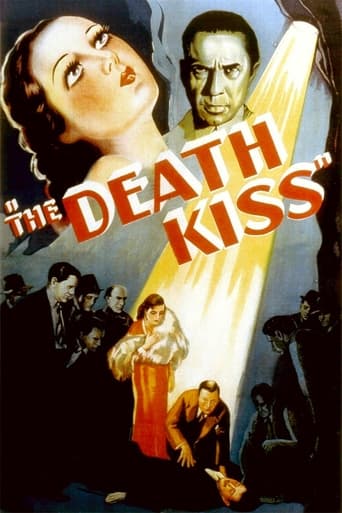gridoon2018
"Death Kiss" has a clever film-within-a-film opening sequence and a memorable high-fall ending, but in the middle it gets plodding. The script has some surprises, but the direction is mostly pedestrian. David Manners is a personable leading man, but Bela Lugosi is largely wasted (the old posters for this film prove that false advertising is NOT a recent practice; they try to make this look like a sequel to "Dracula"!). Warning: the print most commonly found of this public-domain movie, although of generally acceptable quality, contains lots of audio dropouts and missing frames. **1/2 out of 4.
LeonLouisRicci
Early Talkie-Fest that has a Number of Things that make this just a Tad Above the Normal Run of the Mill, Low-Budget Movies that were Churned Out in Hollywood at the Time Faster than Food in Styrofoam. There's Bela Lugosi in a Non-Horror, Non-Leading Role. A Peek Behind the Scenes at the Primitive Sound Stages of 1932. The Reunion of three Major Stars from Dracula (1931). Some Very Effective and Neat use of Limited Color Tinting. Pre-Code Characters that in a Few Short Years would become Extinct, Homosexuals and Ethnic Types. The Plotting of a Movie within a Movie.The Story Unfolds with more Characters and Twists and Red Herrings than Necessary, but Overall it is Worth a Watch for the Aforementioned and while Never Dull in the End it Boils Over from too much in the Pot. Affecting, Interesting, and a Curioso.
hasosch
The emergence of self-reflexivity is always a sign that a certain final level has been reached in the development of thinking or art. Early literature is not self-reflexive: the love-songs of the minstrels are not personal, but following abstract schemes. The antique novels are not narrated in the first person. The individual is hiding behind an invented protagonist. Also early film did not thematize film itself. Perhaps at the basis of avoiding self-reflexivity is the fear to recognize oneself in the mirror. This had been extensively dealt with in the work of E.T.A. Hoffmann. The motives of losing one's mirror-image or one's shadow roots in this fear. In mathematics, iteration leads quickly leads to the well known paradoxes which cannot be solved in classical logic and which let whole system break together."The Death Kiss" (1932) is now in at least three ways an outstanding example of early talky film: First, it is the story of an actor who has to be killed for the shooting of a movie, but at this occasion gets actually shot to death. Second, the movie is a movie on a movie. And third: "The Death Kiss" is both the title of the movie and of the movie in the movie. Furthermore, a special effect is reached - if one wants: number four - by the fact that the actor who wrote the scenario for the movie in the movie (and also for the movie?), which is a criminal story, is also the one who will in the end solve the murder case and deliver the killer to the police which seems to be unable to go ahead without the author of the scenario. As number five, one could mention that Bela Lugosi, who just had played one year ago (1931) the main role in "Dracula", is naturally assumed by the audience to be the villain. But that is not all: As audience, we witness that the detective-author who "investigates" the case also seems to assume over almost the whole running time of the movie that the character Mr. Steiner, played by Lugosi, is in fact the killer. Only in the last couple of minutes we see with him that it is someone else. Herewith not only the expectation of the audience is cheated, but we are forced to follow the progress of the detective-author in our own considerations, i.e. we more or less get ourselves a part of the movie, so that the movie plays on three and not only on two levels: 1. The movie, 2. The movie in the movie, 3. In our perception of the movie and of the movie of the movie. This is an amazing and often overseen movie, and considering it early date quite outstanding.
capkronos
One of the most novel aspects of this low-budget murder-mystery is the opening sequence. It starts with a man being shot near the front entrance of a building before the camera pans around to reveal it's simply a scene being shot in a movie studio. I've seen this same set-up numerous times in other mysteries, thrillers and horror films and don't recall seeing any films predating this one using this film-within-a-film trick at the beginning. But what is supposed to be a simulated murder turns out to be a real one when a member of the cast or crew actually does shoot the actor from somewhere off-screen. The question is, who did it and why? That's what Lt. Sheehan (John Wray) hopes to find out. Usually beating him to the punch though is studio writer Franklyn Drew (David Manners), who decides to play amateur sleuth when the killer tries to implicate his girlfriend - film star Marcia Lane (Adrienne Ames) - in not only the first murder, but also a second one involving a drunk getting battery acid snuck into his liquor.Horror fans will note that three of the leads from Tod Browning's classic Dracula, made just one year earlier, round out the cast, including Manners in the lead role and Bela Lugosi (playing studio president Joseph Steiner) and Edward Van Sloan (playing director Tom Avery) in supporting roles, both as just a couple of the potential suspects. It's also nice to get a look at a 1930s film studio, including sets and camera and sound equipment. The screenplay depends a bit too much on coincidence, with Manners finding many clumsily-left clues just lying around at various locations and the killer conveniently popping in long enough to conk someone over the head so he/she can destroy evidence, for the mystery aspects to be fully satisfactory. And the comedy elements, primarily the ones involving a dim-witted set security guard (Vince Barnett) are a bit strained at times. Despite that, the film is still pretty entertaining and worth watching.


 AD
AD


